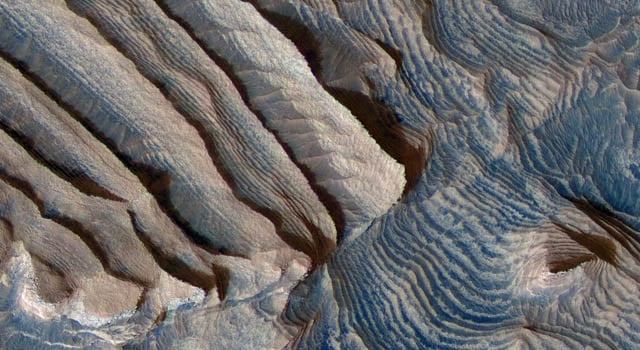[/caption] We see evidence on Mars' surface of a violent past: massive volcanic eruptions, catastrophic floods, and a surface scarred with craters. But new images of rock formations on Mars resembling stairs suggest Mars at one time had a regular pattern of predictable and even moderate climate cycles persisting for millions of years. Three-dimensional images from the HiRISE camera on the Mars Reconnaissance Orbiter show patterns in thick stacks of sedimentary rock layers, formed by a cyclical climate that is likely tied to the wobble of Mars on its axis.
Combining several images of the rock formations from different perspectives, scientists were able to produce three dimensional images, as well as
a dramatic flyby movie of the layered sediments.
Based on a pattern of layers within layers found at an area called Becquerel crater, the scientists propose that each layer was formed over a period of about 100,000 years and that these layers were produced by cyclical climate changes. The outcrops have been eroded into mounds on the floors of the craters, with many of the layered deposits showing a stair-stepped shape. Each layer has exactly the same thickness. [caption id="attachment_21953" align="alignnone" width="250" caption="Sequences of cyclic sedimentary rock layers exposed in an unnamed crater in Arabia Terra, Mars. (Credit, both images: Topography, Caltech; HiRISE Images, NASA/JPL/University of Arizona) "]
[/caption] Every 10 of the "staircase" layers are bundled into a larger unit, which the team, led by Kevin Lewis of the California Institute of Technology, calculates was laid down over a million-year period, and Becquerel contains 10 of these bundles. One million years is the same duration as the periodic variations in Mars' tilt, suggesting that climate variations induced by the tilt produced the layering. Each bundle, then, represents climate processes as the planet tilted. This tilt periodically cooled the equatorial region and warmed the poles as they received more sunlight.
"Due to the scale of the layers, small variations in Mars's orbit are the best candidate for the implied climate changes," said Kevin Lewis of the California Institute of Technology, who led the study. "These are the very same changes that have been shown to set the pacing of ice ages on the Earth and can also lead to cyclic layering of sediments."
[caption id="attachment_21952" align="alignnone" width="226" caption="This image shows sedimentary-rock layering in which a series of layers are all approximately the same thickness. Image credit: NASA/JPL-Caltech/University of Arizona "]
[/caption]
The tilt of Earth on its axis varies between 22.1 and 24.5 degrees over a 41,000-year period. The tilt itself is responsible for seasonal variation in climate, because the portion of the Earth that is tipped toward the sun--and that receives more sunlight hours during a day--gradually changes throughout the year. During phases of lower obliquity, polar regions are less subject to seasonal variations, leading to periods of glaciation.
Mars's tilt varies by tens of degrees over a 100,000-year cycle, producing even more dramatic variation. When the obliquity is low, the poles are the coldest places on the planet, while the sun is located near the equator all the time. This could cause volatiles in the atmosphere, like water and carbon dioxide, to migrate poleward, where they'd be locked up as ice.
"It's easy to be fooled without knowing the topography and measuring the layers in three dimensions," said Alfred McEwen of the University of Arizona, Tucson, principal investigator for the camera and a co-author of the paper. "With the stereo information, it is clear there's a repeating pattern to these layers."
Sources:
JPL
, Caltech
 Universe Today
Universe Today
